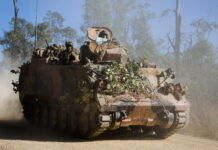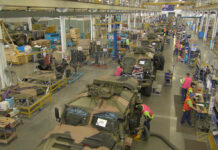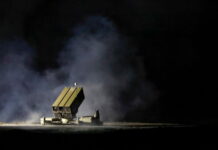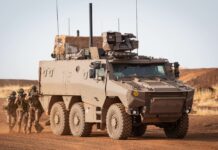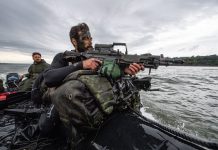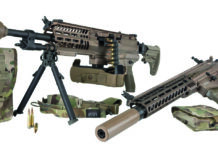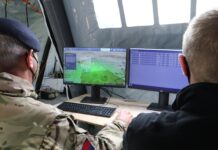The Australian Army found itself in a situation where it was necessary to replace two major elements of its existing armoured vehicle fleet and this led to the development of Project LAND 400. The objective of LAND 400 is to acquire a Combat Reconnaissance Vehicle (CRV), an Infantry Fighting Vehicle (IFV), a Manoeuvre Support Vehicle (MSV) and an Integrated Training System (ITS).
Thus far, progress on meeting these requirements for new armoured vehicles has been more than satisfactory. The first CRV acquired under LAND 400 Phase 2 was handed over to the Australian Army in September 2019, while the IFV requirement of LAND 400 Phase 3 has seen the selection of two competitors on the road to a final acquisition decision.
According to the Australian Army, “LAND 400 aims to enhance the mounted close combat capability of the Land Force by providing armoured fighting vehicles with improved firepower, protection, mobility and communication characteristics to enable tactical success in the contemporary and future operational environment.” In detail, this will require the “staged retirement of the in-service Australian Light Armoured Vehicle (ASLAV) and the M113AS4 Armoured Personnel Carrier (APC) fleets in line with their technical Life of Type and reducing tactical utility in the contemporary operational environment that involves increasing levels of lethality and complexity.” To provide context, LAND 400 Phase 2 covers the ASLAV replacement, while Phase 3 will see the replacement of the M113AS4.
Armour Overture
In the early 1960s, the Australian Army looked to acquire an effective mounted close combat capability. This saw the acquisition of a small number of wheeled armoured vehicles from Britain and, subsequently, a major tracked APC purchase from the US. From Britain they acquired 18 FV601 SALADIN armoured cars, equipped with a 76mm L5A1 gun and a 7.62mm co-ax (delivered in 1960) and more than 20 FV603 SARACEN (delivered in 1959/1960). Neither the SALADIN or the SARACEN made much of an impression with the Australian Army and both vehicles were taken out service somewhat rapidly. However, the turrets and 76mm guns of the SALADIN would go on to find a new home on a different Australian vehicle.
Unlike their wheeled vehicle selection, their tracked vehicle programme can certainly be considered as a success. They identified the British FV432 and the US M113A1 as potential candidates for their requirement and trialled both vehicles in Australia between November 1962 and April 1963. The M113A1 proved superior to the FV432, with orders for the M113A1 being placed in 1963, deliveries commencing in 1964, with the vehicle entering service in March 1965 and replacing the SARACEN.
In total, the Australian Army would acquire some 800 M113A1 vehicles in numerous variants with deliveries continuing through to the late 1970s. These included the standard M113A1, M125A1 81mm mortar carrier, M577A1 command vehicle, M113A1 Fire Support Vehicle (FSV) mounting the SALADIN turret (15 converted), M806A1 ARV, M113A1 fitters’ vehicle, M548 logistic load carrier and the FSV replacement in the form of the M113A1 fitted with the turret of the British SCORPION light tank mounting a 76mm L23A1 gun. Later known as the Medium Reconnaissance Vehicle (MRV), some 48 M113A1s were converted to this configuration.
By the 1980s, Australia was looking to acquire a successor system to the M113A1, believing that the M113 would reach the end of its service life by 1995. The replacement programme was known as Project Waler and both wheeled and tracked options were to be considered, with between 800 and 1,000 vehicles to be acquired. The winning Project Waler vehicle was to be produced in Australia and vehicle submissions had been received from FMC (now BAE Systems), Krauss-Maffei (now KMW) and Vickers (now BAE Systems) amongst others. The scope and therefore the cost of Project Waler was such that the Australian government decided to postpone the programme, instead opting to look into a life extension and upgrade programme for the M113 fleet.
This resulted in Project LAND 106, the ultimate objective of which was to extend the service life of the M113 out to 2010 and enhance the operational capabilities of the vehicle. Initially, there was a demonstration phase and this was to be followed by the actual upgrade programme for a total of 537 vehicles to be conducted in two phases. Then the programme, as originally envisaged was halted, discussions on M113 upgrades continued through the 1990s and finally in 2002 a contract was signed with the local company Tenix to upgrade 350 M113s and extend their service life to beyond 2020.
Eventually 431 M113A1s were included in the upgrade programme and seven different variants were produced. The rest of the M113 fleet was either sent for scrap, with some 30 vehicles being preserved for display purposes. Delivery of the first 16 upgraded M113AS4 was in November 2007 and final deliveries were made in late 2012. The upgrade was more complicated and costly than expected, originally it was due to be complete December 2010. On the other hand, the Australian Army did eventually end up with a vehicle that could be viable out to 2030.
While it was investigating its options as regards tracked armour in the 1980s, the Australian Army also looked into acquiring a new wheeled armoured system. This led it to acquire 15 General Dynamics Land Systems (GDLS) LAV-25 vehicles for evaluation and trials in Australia under what would become Project LAND 112. This initial buy proved the concept of wheeled armour and it was decided to proceed with the acquisition of a modified LAV-25 vehicle known as the ASLAV. In total Australia would acquire 257 ASLAV vehicles in seven different variants, with first orders placed in 1992. According to the Australian Army they needed to replace the ASLAV “due to obsolescence factors that constrain tactical employment and increase the cost of ownership. These obsolescence factors cannot be mitigated through upgrade and without replacement starting in 2020, a capability gap will result.”
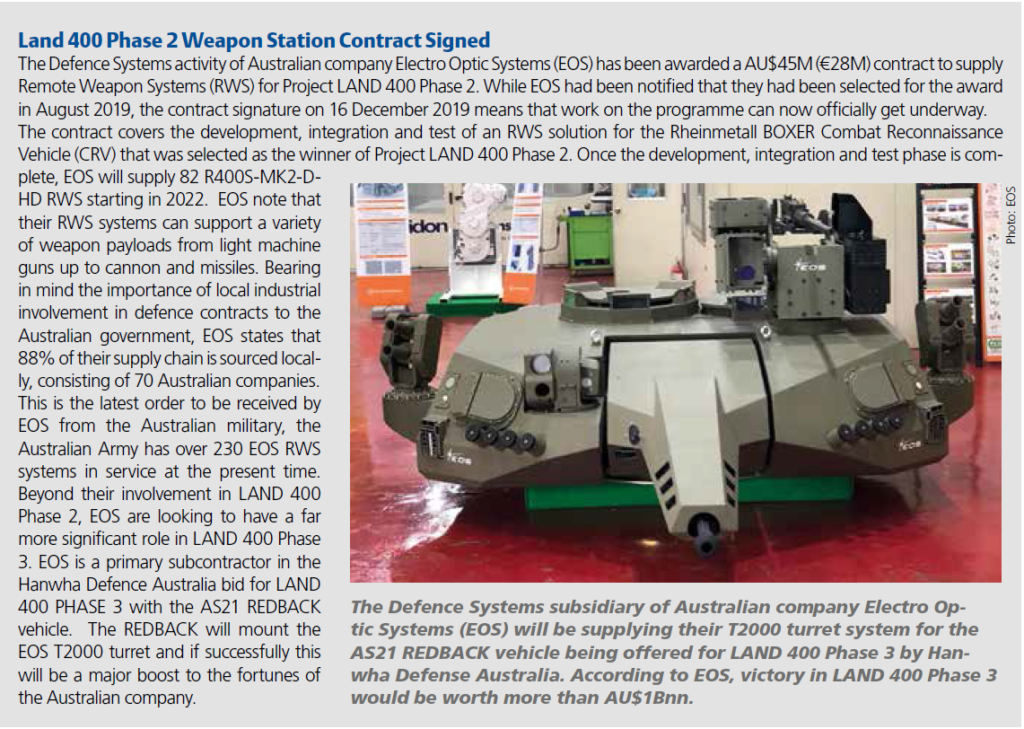 Armour Renaissance
Armour Renaissance
Clearly the need to replace the Australian Army ASLAV and M113AS4 fleets would be an extremely ambitious and inevitably expensive undertaking. The resulting Project LAND 400 was officially described as the largest and most expensive procurement programme in the history of the Australian Army. According to the Australian government, total programme value is between AU$14Bn (€8.64Bn) and AU$20Bn (€12.345Bn), covering the acquisition of 611 armoured vehicles over 15 years. Additionally, maintenance and support contracts will cover the sustainment of these vehicles over 30 years.
Project LAND 400 was divided into four distinct phases. LAND 400 Phase 1 was the project definition study defining the scope of the requirements and the roles and missions that would need to be fulfilled. As previously noted, Phase 2 covers the acquisition of a Combat Reconnaissance Vehicle (CRV) to replace the ASLAV, Phase 3 covers the acquisition of an Infantry Fighting Vehicle (IFV) and a Manoeuvre Support Vehicle (MSV) replacing the M113AS4, while Phase 4 covers the acquisition of an Integrated Training System.
The first element of LAND 400 to be awarded was Phase 2 covering the acquisition of a wheeled CRV. Candidates for the programme had included: BAE Systems with the AMV 35, a variant of the Patria AMV with the E35 turret of the CV9035 IFV. Elbit offered the SENTINEL 2, the Singapore Technologies Kinetics TERREX 3 vehicle fitted with the Elbit MT30 turret. Rheinmetall offered the BOXER vehicle, while Thales and the Australian subsidiary of General Dynamics Land Systems (GDLS-A) offered the LAV 6.0 vehicle. Others companies had looked into the programme but decided not to participate.
In July 2016, Australia identified the BAE Systems and Rheinmetall proposals as offering the best basis for selecting a Phase 2 solution and started a further evaluation effort. Then on 14 March 2018, the Australian Department of Defence announced that it had selected Rheinmetall and the BOXER vehicles as the winner of LAND 400 Phase 2. It noted that, ”The decision to select Rheinmetall is the result of a comprehensive three-year tender and rigorous testing process, which assessed its BOXER CRV as the most capable vehicle for the Australian Defence Force.” It was also stated that, “The Government will spend AU$5.2Bn (current value €3.226Bn) to acquire the 211 vehicles, which will replace the Army’s current ageing Australian Light Armoured Vehicle (ASLAV) fleet.”

to be acquired under Project LAND 400 Phase 3. (Photo: Commonwealth of Australia)
An important aspect of these LAND 400 acquisitions is that the Australian government intends that they support both the enhancement and sustainment of the Australian defence industrial capability. The Australian government stated that, “Over the 30-year life of the vehicles, Australian industry will secure AU$10.2Bn (current value €6.328Bn) of the total investment in acquiring and maintaining the fleet.”
Fleet sustainment is only part of the LAND 400 Phase 2 industrial story. The first 25 BOXER vehicles will come from Germany; the rest will be sourced from the Military Vehicle Centre of Excellence (MILVEHCOE) established by Rheinmetall near Brisbane in partnership with the Queensland State Government. According to Rheinmetall, ”The MILVEHCOE will serve as the focal point for the execution of the programme and a base for the establishment of an export orientated military vehicle industrial complex in Australia.” This new industrial facility is described as “state-of-the-art” by Rheinmetall, and Rheinmetall will be transferring technologies in such areas as “military vehicle design, production, turret systems, sensors, survivability” to MILVEHCOE.
On 24 September 2019, Rheinmetall handed over the first BOXER CRV to the Australian Army at Enoggera Barracks in Brisbane, Queensland. September 2019 also saw substantial progress as regards LAND 400 Phase 3, in that it was announced that Rheinmetall and Hanwha Defence had been shortlisted for further evaluation. This will see the two candidates subject to rigorous testing and evaluation, as well as working with Australian industry to maximise the local content in their proposals. This process will commence in the third quarter of 2020 and be completed in the third quarter of 2021, with a decision on the winning candidate due in 2022.
Tracked Investment
Originally, four contenders had responded to the Request for Tenders (RfT) for LAND 400 Phase 3. These were BAE Systems with the CV90 Mk 4, GDLS with the AJAX, Hanwha Defence Australia with the AS21 REDBACK and Rheinmetall with the KF41 LYNX. The original requirement was framed around the acquisition of 383 IFVs and 17 Manoeuvre Support Vehicles (MSV). The IFV element would consist of eight separate variants, of which 232 would feature a manned turret. As regards the MSV this was originally envisaged as a dedicated combat engineer platform whose role would be to “overcome enemy constructed obstacles and to aid the construction of defensive fortifications.” The MSV will now be more closely related to the standard IFV, most likely a developed and more capable version of the combat engineer variant of the IFV.
Added to the numbers of IFVs and MSVs, there was a Request for Information (RFI) on the supply of 27 IFV logistics vehicles, 15 mortar carriers with 120mm calibre mortar, and 25 mortar ammunition carriers. An additional RFI covers the provision of 50 vehicles for amphibious operations, though these do not have to be a variant of the IFV. Without doubt the number of vehicles to be acquired under the umbrella of LAND 400 Phase 3 make this a highly desirable programme by any international standard.
As with the Phase 2 programme indigenous industrial involvement and capability development will be critical issues in selecting the vehicle to meet the Phase 3 requirement. With Rheinmetall already having an armoured vehicle manufacturing infrastructure in Australia, the MILVEHCOE in Queensland, thanks to their victory in the Phase 2 programme, this would appear to strengthen their KF41 LYNX offer for Phase 3. However, the Hanwha proposal should not be underestimated; their REDBACK vehicle is based on the K21 IFV that is already in service in large numbers with the Republic of Korea Army (ROKA) and this Korean company has a strong defence pedigree.
In the context of their offer for the Phase 3 programme Hanwha has established Hanwha Defence Australia to prime their efforts, with team members Electro Optic Systems (EOS), an Australian company whose T2000 turret will be used on the REDBACK vehicle, as a primary subcontractor, and Elbit. Hanwha is also working with the government of the Australian state of Victoria and intend to establish a manufacturing facility at Geelong near Melbourne.

Another possibility has emerged that could allow Hanwha to further sweeten its offer to Australia. A new requirement has emerged in the form of Project LAND 8116 Protected Mobile Fires. In essence, this is a self-propelled artillery requirement covering much of the same ground as the LAND 17 Artillery Replacement Programme that was cancelled in 2012. The Hanwha K9 155/52mm self-propelled gun system had been offered for LAND 17 and was apparently highly thought of.
Now it appears that a new variant K9 optimised for LAND 8116, along with the K10 Ammunition Resupply Vehicle (ARSV), based on the same chassis, are being offered for the new artillery requirement. The Hanwha proposal is said to cover over 30 K9 guns and more than 10 K10 ARSV. As the K9 and K10 share the same automotive elements as the K21/AS21 there are commonality advantages between the vehicles, and Hanwha would look to manufacture the K9 and K10 at their Geelong facility.
There is still a long way to go before the fate of LAND 400 Phase 3 is settled, thus far though the LAND 400 programme appears to be progressing extremely well. With BOXER being selected for the Phase 2 programme and an industrial infrastructure to build the vehicle being established in Australia, that is a win for the Australian military and for the Australian defence industry. With Phase 3 being a much bigger programme in terms of cost and number of vehicles, the impact of this programme in Australia will be much greater. Also of interest will be the evolution of a competition between European and Korean defence companies for a major international programme which will be worthy of much analysis.
David Saw is a specialist defence writer based in Paris, France. He has a long and comprehensive record of writing and managing defence magazines at the highest level, from the USA through Europe to Asia, and is now a regular contributor to ESD.



